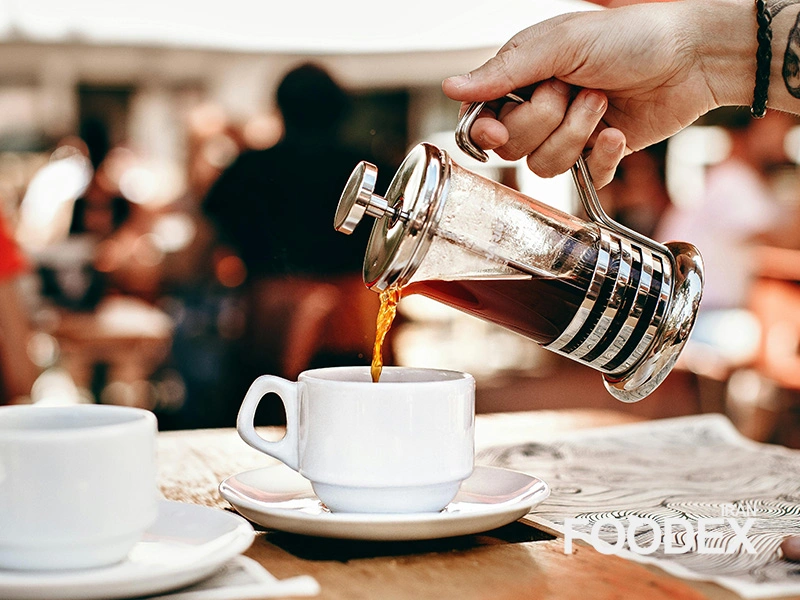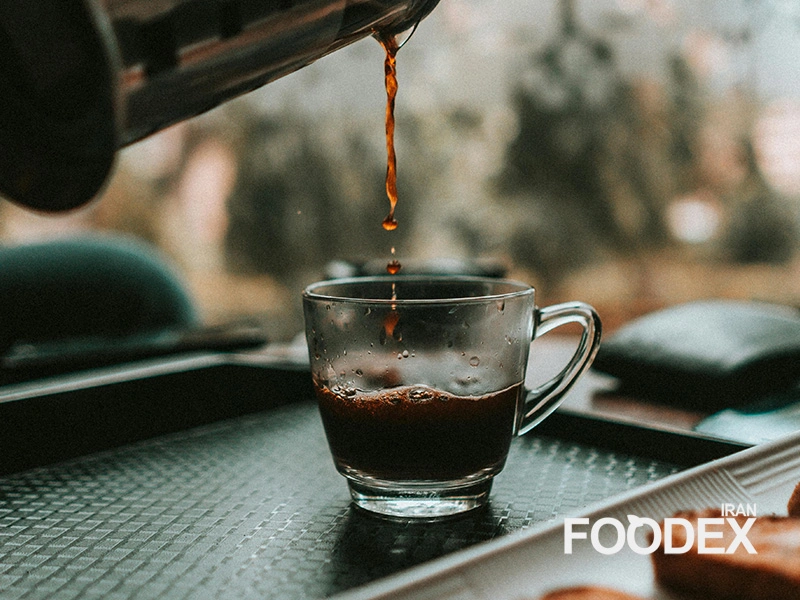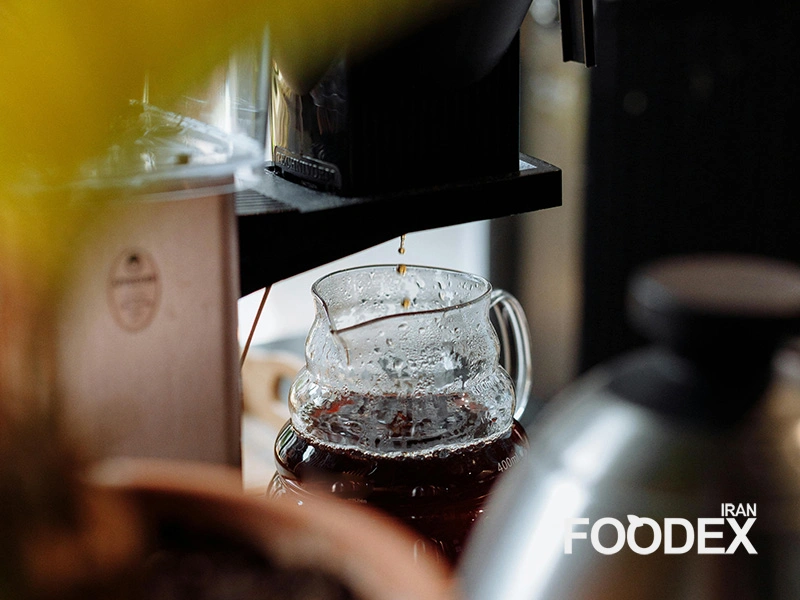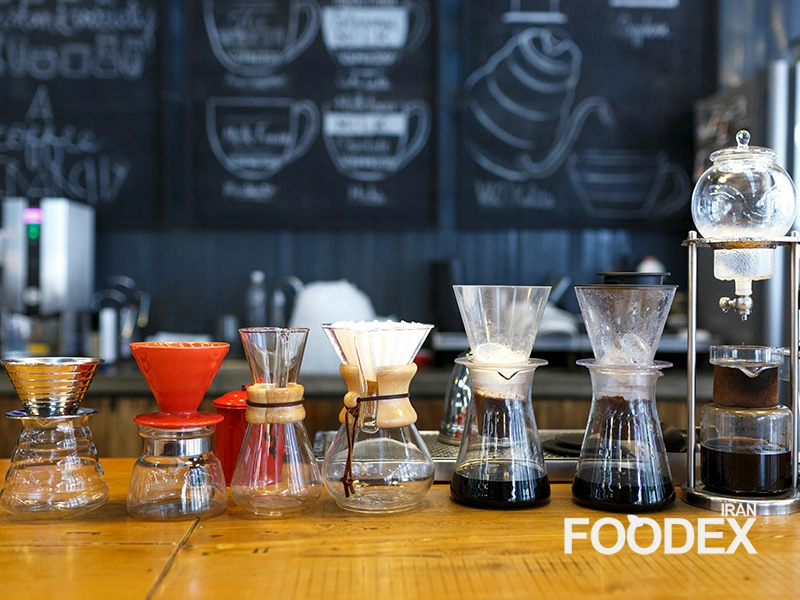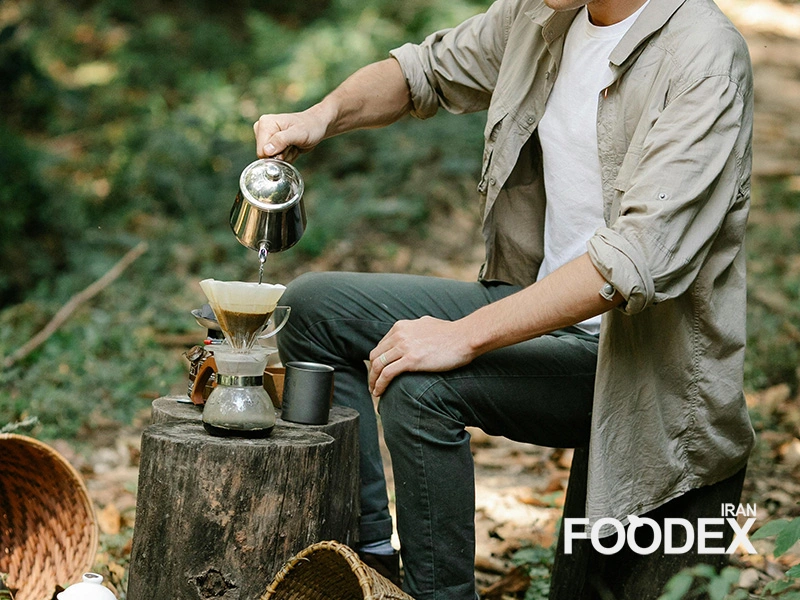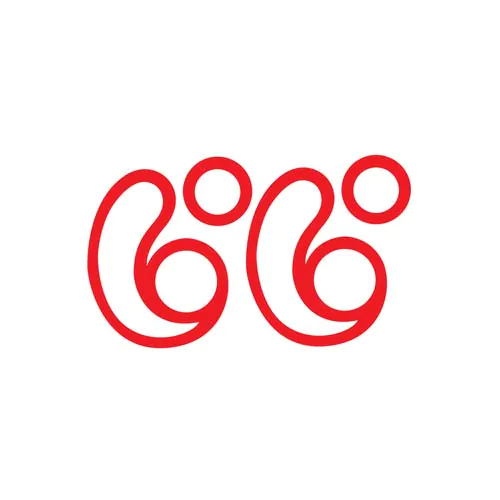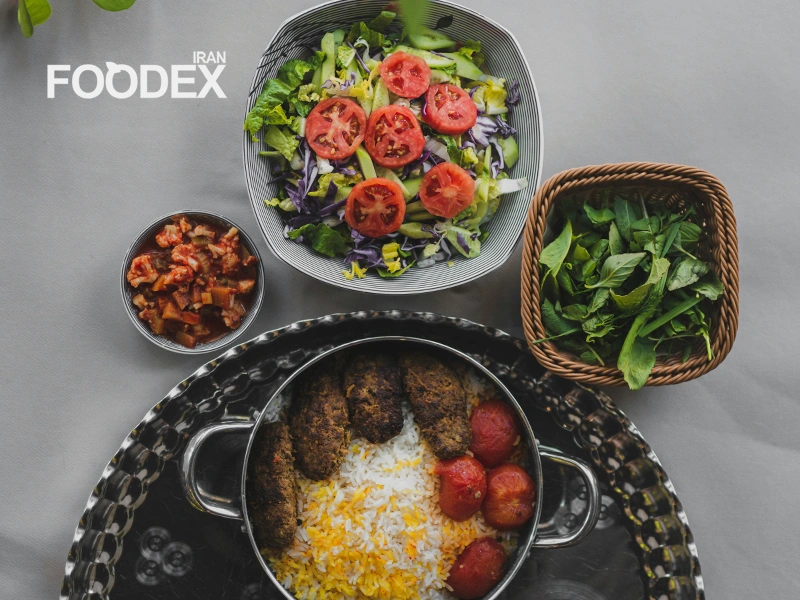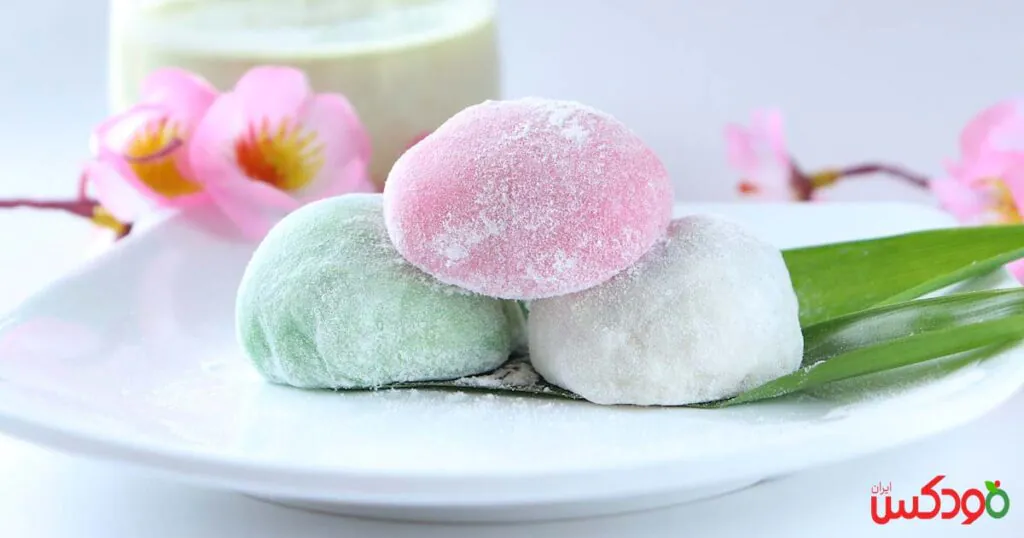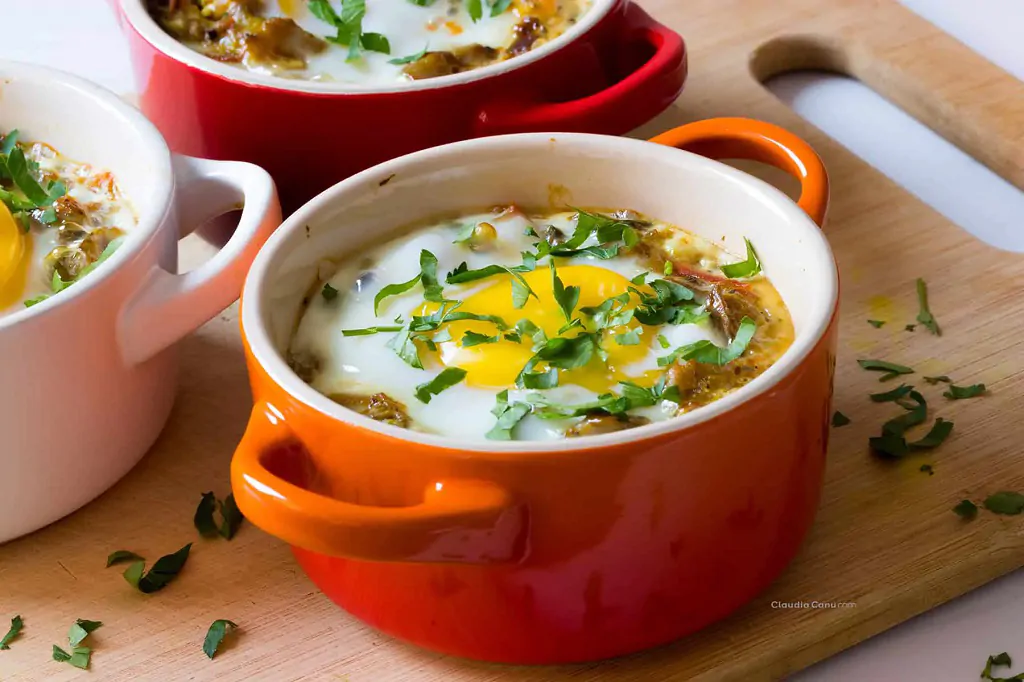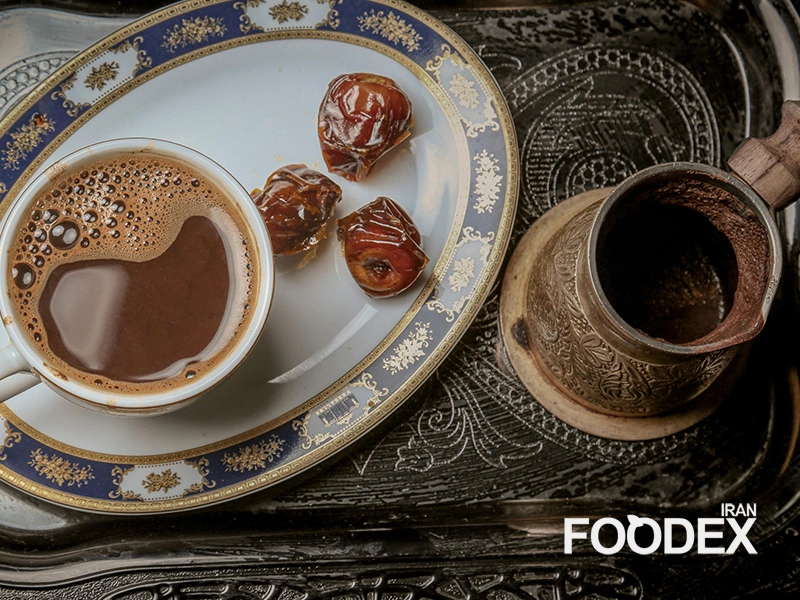While the name ‘French coffee’ might be familiar within certain regions, it’s noteworthy that internationally, this term typically refers to brewing methods such as Drip Coffee, Filter Coffee, or Pour Over Coffee. It doesn’t necessarily have a direct connection to contemporary coffee culture within France itself. Nevertheless, due to its relatively straightforward preparation process and its balanced, clean taste profile, this style of coffee ranks among the most popular ways to consume coffee globally, especially as a daily beverage.
Although its preparation may lack the technical complexities of espresso, achieving a drip coffee with desirable aroma and flavor necessitates attention to crucial details, including bean selection, appropriate grind size, water quality, and proper brewing technique. In this expert guide from the Foodex blog, we aim to familiarize you with the principles of preparing authentic drip/filter coffee (the style sometimes known locally as ‘French coffee’) and to detail the common methods for preparing it using various tools. To expand your knowledge of hot beverages, we recommend exploring other specialized articles in our Cooking Tutorials section on the Foodex blog. Join us as we explore this popular brewing method step by step.
What is ‘French Coffee’? (Definition, International Equivalents, and Background)
Following the introduction, let’s delve into a more precise definition of the beverage sometimes known regionally as ‘French coffee’. It is worth noting that this nomenclature is primarily regional; globally, this style of coffee preparation is known by terms such as Drip Coffee, Filter Coffee, or Pour Over Coffee. This method generally involves passing hot water over ground coffee powder and then filtering out the grounds, typically resulting in a clearer beverage with a milder flavor compared to espresso or Turkish coffee.
Interestingly, despite this naming difference, the roots of some of the earliest modern filter brewing methods trace back to 18th-century France and innovations by individuals like Jean-Baptiste de Belloy, who sought ways to reduce coffee’s bitterness. Therefore, although the beverage sometimes known by the regional name isn’t directly ‘French’, the historical background of this brewing style is not entirely unrelated to France. Today, owing to its relative ease of preparation and balanced taste, this style of coffee is consumed as a popular daily beverage in many parts of the world, particularly at breakfast.
Drip or filter coffee is typically served in larger volumes compared to espresso or Turkish coffee and has a lower concentration. Regarding caffeine content, it’s important to note that the amount depends on multiple factors, such as the type of bean (Arabica or Robusta), the precise water-to-coffee ratio used during brewing, and the final serving volume, meaning it can vary considerably. Although its caffeine concentration (mg per ml) is lower than espresso, the total caffeine intake per serving can be substantial due to the larger volume consumed.
Drip/Filter Coffee Preparation: Key Principles and Common Tools
As mentioned, preparing drip or filter coffee (sometimes known regionally as ‘French coffee’) involves a relatively straightforward process, making it suitable for daily home consumption or preparing larger volumes for guests. However, it should be noted that the coffee’s aroma and flavor quality are always optimal when freshly brewed. Nevertheless, achieving a cup with desirable quality and taste using these methods requires understanding and adhering to several key principles.
Three crucial factors play an essential role in the final quality of your drip coffee:
- Coffee bean grind size
- Roast level
- Water quality
- Grind Size: For most drip/filter methods, a medium to medium-coarse grind is ideal. The grind should generally be coarser than that used for espresso but finer than required for a French Press (although a coarser grind is recommended for the French Press itself). Too fine a grind can clog the filter or lead to over-extraction, resulting in a bitter and astringent taste, while too coarse a grind allows water to pass through too quickly, leading to under-extraction and a weak, watery coffee.
Roast Level: While roast choice depends on personal preference, typically a light to medium roast best showcases the inherent flavor characteristics and aromatic complexities of the coffee beans in drip/filter methods. Darker roasts may introduce dominant burnt or smoky flavors that can overwhelm the coffee’s nuances.
Water Quality: Since over 98% of your cup of coffee is water, its quality is paramount. Using filtered or quality bottled mineral water that is free of chlorine and has a balanced mineral content (water that is neither too hard nor completely devoid of minerals) instead of tap water with strong odors or high hardness will significantly improve the clarity and quality of the final coffee taste.
A variety of tools can be used to prepare drip/filter coffee. Among the most common, which we will detail how to use in the following sections, are:
- French Press
- Automatic Drip Coffee Maker
- Chemex
- (Other popular manual brewing devices like the Hario V60, Kalita Wave, and Aeropress also fall into this category.)
Familiarizing yourself with different brewing methods can greatly enrich your experience of the vast world of coffee. If you have previously tried drip coffee and are looking for a method with a completely different concentration and mouthfeel, we also recommend reading our article on How to Make Turkish Coffee.
Method 1: Preparing Coffee with a French Press
The French Press is a popular and classic tool for brewing immersion coffee, known for its relative simplicity and ability to produce coffee with a full body and rich flavor. In this method, the coffee grounds are not completely filtered out, allowing some oils and fine particles to remain in the beverage, which contributes to these characteristics.
Required Equipment and Ingredients
- A clean French Press device
- Coffee powder with a Coarse Grind (particle size should resemble coarse sea salt or cracked pepper). (This grind size is crucial for French Press)
- Fresh, high-quality water (filtered or bottled mineral water without strong taste is recommended)
- Kettle (preferably a gooseneck kettle for better pouring control)
- Digital scale (optional but highly recommended for accuracy)
- Timer
- Spoon (preferably wood or plastic for stirring, if needed)
- Suggested Coffee-to-Water Ratio: As an excellent starting point, we recommend a ratio of 1:16 by weight (1 gram of coffee per 16 grams or milliliters of water). For example, use about 30-31 grams of coffee for 500 milliliters (approx. 17 fl oz) of water. If you don’t have a scale, you can very approximately use about 2 level tablespoons of coarse grounds per 6 fluid ounces (180ml) of water, but note that measuring by weight offers far greater accuracy and yields better, more consistent results.
Preparation Steps
Heat Water: Heat fresh water in a kettle to approximately 93°C to 96°C (200°F to 205°F). If your kettle doesn’t have a thermometer, bring the water to a boil and then let it sit for about 30-45 seconds to cool slightly.
Preheat Press (Optional but Effective): Remove the lid and plunger assembly. Pour some hot water into the glass carafe, swirl it around to warm the body, then discard the water. This helps maintain the brewing temperature.
Add Coffee Grounds: Weigh the desired amount of coarsely ground coffee and add it to the bottom of the empty, preheated French Press.
Bloom the Coffee (0:00 – 0:30): Set your timer for 4 minutes and start it. Gently pour about twice the weight of the coffee in hot water over the grounds (e.g., 60ml water for 30g coffee), ensuring all grounds are saturated. Wait for 30 seconds. You’ll see the coffee puff up and possibly bubble; this is the release of CO2 from fresh coffee, known as the ‘bloom’, crucial for flavor development.
Add Remaining Water (0:30 – ~1:00): After the 30-second bloom, slowly and evenly add the rest of the hot water to the French Press until you reach your target volume or weight (e.g., up to 500ml or 500g total for 30g coffee).
Stir Gently (Optional – ~1:00): About 1 minute after pouring all the water, a crust of grounds may have formed on top. Some baristas gently break this crust with a spoon or give one very gentle stir to ensure all grounds are submerged for even extraction.
Place Lid and Steep (1:00 – 4:00): Place the lid/plunger assembly on top of the press with the filter plate just above the water line, but do not press the plunger down yet. Let the coffee steep undisturbed until the timer reaches a total of 4 minutes.
Press the Plunger (4:00): Exactly after 4 minutes, firmly grip the plunger handle and press it down slowly, steadily, and straight all the way to the bottom. This separates the grounds from the brewed coffee. If you encounter significant resistance, your grind might be too fine.
Serve Immediately: Pour the coffee into your cup(s) immediately after pressing. It’s crucial to decant all the coffee from the press, as leaving it in contact with the grounds will cause continued extraction, resulting in a bitter, astringent taste over time.
Additional Tips
Adjusting Taste: Coffee taste is personal. If the result is weak for you, try using a slightly higher coffee-to-water ratio next time (e.g., 1:15) or a slightly finer grind (still within the coarse range). If it’s bitter or harsh, try a coarser grind or slightly reduce the steep time (e.g., to 3:30 minutes).
Steep Time: 4 minutes is an excellent standard starting point for most coffees in a French Press. Over-steeping (e.g., 8-10 minutes, sometimes mistakenly recommended) usually has adverse effects, extracting undesirable bitterness rather than adding desirable strength. Experimenting within the 3:30 to 5-minute range generally yields better results.
Method 2: Preparing Coffee with an Automatic Drip Coffee Maker
Automatic drip coffee makers are among the most common tools for brewing coffee in homes and offices due to their ease of use and speed. These machines automate the process of heating water and pouring it over the coffee grounds. Although operating these machines seems simple, adhering to a few key points is essential for achieving the best possible flavor and avoiding weak or bitter coffee.
Key Tips for Better Results
Grind Size: Unlike the French press, which requires a coarse grind, a medium grind (roughly the consistency of coarse sugar or slightly finer) is more suitable for most automatic coffee makers. Using too coarse a grind in these machines typically leads to under-extraction and weak coffee.
Coffee-to-Water Ratio: For a balanced and standard cup, a weight ratio of 1:16 or 1:17 (1 gram of coffee per 16 or 17 grams/ml of water) is an excellent starting point. This equates to approximately 55 to 60 grams of coffee per 1 liter of water. Many machines come with specific scoops, but for greater accuracy and repeatability, especially if coffee quality is important to you, using a digital scale is highly recommended.
Filter: Use the appropriate filter type for your machine (usually paper or sometimes a permanent filter). If using a paper filter, an effective step to improve taste is to rinse the filter with hot water before adding the coffee grounds. Place the filter in the basket, pour some hot water over it (letting the water drain through), and then discard the rinse water. This removes any potential papery taste and helps preheat the basket and carafe.
Water: As previously mentioned, water quality is very important. Always use cold, fresh, high-quality water (preferably filtered or bottled mineral water without strong off-tastes) in the machine’s reservoir.
Cleaning: Mineral deposits from water and coffee oils accumulate in the machine over time and can negatively impact the coffee’s taste. Regularly cleaning all parts of the machine (reservoir, filter basket, showerhead, carafe) according to the manufacturer’s instructions is essential for maintaining flavor quality.
General Preparation Steps
- Place the appropriate filter in the machine’s filter basket (if using paper, rinse it first as described above).
- Measure the required amount of medium-grind coffee powder and add it evenly into the filter.
- Fill the machine’s water reservoir with the appropriate amount of fresh, cold water (based on the coffee ratio you are using).
- Place the clean carafe under the filter basket and turn the machine on. The brewing process (heating water and dripping it over the grounds) will proceed automatically.
- Very Important Tip for Flavor Preservation: As soon as the brewing cycle is complete and the carafe is full, if possible, remove the carafe from the machine’s warming plate. Keeping the coffee on the hot plate for extended periods will cause it to ‘bake’, resulting in a bitter, unpleasant taste and loss of aroma. Drip coffee is best consumed shortly after brewing (e.g., within 30 minutes) or transferred to a pre-heated thermal carafe for longer keeping.
Method 3: ‘French’ (Drip) Coffee and the Moka Pot
The question sometimes arises whether a Moka pot, typically used at home to brew strong, espresso-like coffee, can also be used to brew drip or filter coffee (sometimes known regionally as ‘French coffee’). Although it might seem physically possible, due to technical reasons and the fundamental differences between these two brewing styles, a Moka pot is not considered the ideal tool for preparing high-quality drip/filter coffee.
Moka pots utilize steam pressure generated in the lower chamber to force hot water through coffee grounds that are relatively finely ground (Fine to Medium-Fine), producing a concentrated, potent beverage quickly. In contrast, the goal of drip/filter methods (like French Press, Chemex, or automatic brewers) is to pass hot water (primarily using gravity or full immersion) through coffee grounds with a medium to coarse grind and typically with a longer contact time, aiming for a cleaner, lighter-bodied beverage with more clarity and nuanced flavors.
So, what happens if we use a medium or coarse grind (suitable for drip/filter coffee) in a Moka pot? The pressurized water finds an easier path through the coarser grounds, passing through too quickly and without sufficient contact time for proper and complete extraction. The likely result of this process is a coffee that is weak, watery, lacking depth of flavor, and possibly unpleasantly sour (referred to as ‘under-extracted’). This is the opposite of what one expects from a Moka pot. Conversely, if you were to use a finer grind (appropriate for the Moka pot) to achieve a stronger brew, you would no longer be preparing drip/filter style coffee; the resulting beverage would simply have the characteristics of standard Moka pot coffee (which is perfectly fine if that is the intended goal).
Therefore, to achieve the best results and experience the true, desirable taste of drip or filter coffee (‘French coffee’), it is strongly recommended to use tools specifically designed for this purpose, such as a French Press, an automatic drip coffee maker, or pour-over devices (like Chemex, V60, etc.). Reserve the Moka pot for preparing the rich, espresso-like coffee it was intended to make.
Method 4: Preparing Coffee with a Chemex Pour Over
The Chemex is not just a coffee brewing device; it’s also recognized for its elegant and iconic design, even featured in the Museum of Modern Art in New York. This method, a type of Pour Over, utilizes its own specific thick bonded paper filters (Chemex Bonded Filters), resulting in a coffee with a lighter body, high flavor clarity (a ‘Clean Cup’), and virtually no sediment or oils. Preparing coffee with a Chemex requires a bit more precision and control over the water pouring process compared to automatic machines, but the result can be exceptionally rewarding.
Required Equipment and Ingredients
- Chemex Brewer (in the desired size)
- Chemex Bonded Filter (square or circle, matching the brewer model)
- Coffee powder with a Medium-Coarse Grind. The grind size should be slightly finer than for French Press (resembling coarse sand or sea salt)
- Fresh, high-quality water (filtered or bottled mineral water)
- Gooseneck Kettle (highly recommended for precise control over water flow and placement)
- Accurate Digital Scale (for weighing coffee and water)
- Timer
- Suggested Coffee-to-Water Ratio: Similar to other standard drip methods, a weight ratio of 1:16 or 1:17 (1 gram of coffee per 16 or 17 grams of water) is a good starting point. (Example: 30 grams of coffee for approximately 500 grams or milliliters of water).
Preparation Steps
Heat Water: Heat fresh water in the kettle (preferably gooseneck) to approximately 93°C to 96°C (200°F to 205°F). (Alternatively, boil and then wait about 30-45 seconds).
Prepare Filter: Fold the Chemex paper filter according to its instructions. (Typically, for square or circle filters, fold it so one side has three layers and the other has one). Place the folded filter into the top cone of the Chemex brewer, ensuring the three-layered side is positioned towards the pouring spout.
Rinse and Preheat: Pour a generous amount of hot water (around 100-200ml) circularly over the paper filter, wetting it completely and allowing it to adhere to the glass walls. This rinses out any potential paper taste and preheats the Chemex brewer. Carefully discard the rinse water collected in the bottom by pouring it out through the spout while holding the filter securely in place.
Add Coffee: Weigh the desired amount of coffee grounds (e.g., 30g, medium-coarse grind) and pour them into the rinsed, damp filter. Gently shake the Chemex to level the coffee bed. Place the Chemex with the coffee onto the digital scale and tare it to zero.
Bloom Phase (0:00 – 0:45): Start the timer. Slowly pour about twice the weight of the coffee in hot water (e.g., 60g of water for 30g of coffee) in a circular motion over all the grounds, starting from the center and moving outwards. Ensure all grounds are saturated. Wait 30 to 45 seconds for the coffee to ‘bloom’ (release CO2 and expand). This step is crucial for flavor development.
Main Pour Phase (0:45 – ~3:00): Now, add the remaining hot water (e.g., another 440g to reach the total target of 500g) slowly and with full control. You can do this in several stages (pulses of pouring with short pauses) or with one continuous, very slow spiral pour. Pour in concentric circles, starting from the center and moving towards the edge, but avoid pouring directly onto the paper filter walls. Try to maintain a relatively consistent water level within the filter (don’t flood it or let it run completely dry between pulses). This main pouring stage should take approximately 2 to 2.5 minutes.
Drawdown Phase (~3:00 – ~4:30): Once all the required water has been added, allow all the water remaining above the coffee bed to drip through into the bottom chamber of the Chemex.
End of Brew: The entire process, from starting the timer until the water has completely finished dripping (drawdown), should ideally take between 3.5 to 5 minutes total (often targeting around 4:00-4:30), depending on the batch size, grind coarseness, and your pouring technique. A brew time significantly shorter might indicate under-extraction (grind too coarse / pour too fast), while a significantly longer time might indicate over-extraction (grind too fine / pour too slow).
Serve: Carefully lift the paper filter containing the wet grounds out of the Chemex and discard it. Gently swirl the brewed coffee in the Chemex to ensure it’s mixed, then pour into cups and serve immediately.
Suggested Additives for Drip/Filter Coffee (‘French Coffee’)
One appealing characteristic of drip or filter coffee is its relatively clean taste and balanced base, which pairs well with various additions for creating variety and personalizing the flavor. Unlike some other brewing methods, additives for drip/filter coffee are typically incorporated after the brewing process is complete, usually when serving into the cup. Below, we explore several common and popular options:
Milk or Cream
Adding cold or warm milk, or a splash of cream, is the most common way to mellow the flavor and add a creamy texture to drip coffee. It’s best practice to serve milk or cream separately alongside the coffee cup, allowing each person to add their desired amount according to preference.
Sweeteners
To sweeten your drip coffee, besides white or brown sugar, you can use other options like honey, maple syrup, or various natural or artificial sweeteners. The sweetener should be added to the coffee after it has been brewed and poured into the cup. The amount is entirely dependent on your personal taste.
Chocolate or Cocoa Powder
To create a mocha flavor (a combination of coffee and chocolate), you can add chocolate to your drip coffee. The best approach is after brewing the coffee: mix a small amount of high-quality cocoa powder (sweetened or unsweetened, depending on preference) with a little of the hot coffee or some hot milk in the cup first to create a smooth paste, then add the rest of the coffee. Using a prepared chocolate syrup is also a simpler alternative. Adding cocoa powder directly to the dry coffee grounds before brewing is generally not recommended, as it can negatively affect the even extraction of the coffee and may result in a chalky or unpleasant taste.
Spices (e.g., Cinnamon, Cardamom, Nutmeg)
To add a layer of warmth and aroma, you can use spices. It’s recommended to add a very small amount (e.g., a pinch or the tip of a teaspoon) of ground cinnamon, ground cardamom, or freshly grated nutmeg to the prepared coffee in your cup and stir. Another method is to use a cinnamon stick as a stirrer in the cup. Adding spices directly to the coffee grounds before brewing, besides potentially affecting extraction, might create an overpowering flavor that masks the coffee’s original notes.
Other Flavorings (e.g., Vanilla)
A few drops of pure vanilla extract or a small amount of vanilla-flavored syrup (or other flavors like caramel, hazelnut, etc.) added to the coffee after brewing is a quick and easy way to introduce flavor variety to your beverage.
Conclusion: Preparing Quality Drip (‘French’) Coffee at Home
In this guide, we journeyed into the world of drip or filter coffee, a method sometimes known regionally as ‘French coffee’. We examined how this popular brewing style, despite its apparent simplicity compared to pressure-based methods like espresso, requires understanding and applying specific principles to achieve the best results. We discussed the fundamental importance of selecting the right beans, the correct grind size (typically medium to coarse depending on the device), the precise coffee-to-water ratio, and the quality and temperature of the water.
We also reviewed preparation methods using common tools such as the French Press, automatic drip coffee makers, and the Chemex, noting that each technique can yield a different flavor profile. Furthermore, we highlighted the possibility of personalizing the taste using various additives after brewing and explored why using a Moka pot is not recommended for this brewing style.
The aim of providing these details was to demonstrate that with the right tools, a bit of care, and foundational knowledge, you can elevate your daily coffee experience at home or work to a much higher level of quality and enjoyment. Mastering these methods may require some practice and experimentation, but the results will undoubtedly be worthwhile.
The world of coffee is vast and full of fascinating techniques and flavors. To continue your exploration in this field, learning about specialty coffee beans, other brewing methods (such as Aeropress or Siphon), and more advanced tips, we invite you to read further articles in our Cooking Tutorials section on the Foodex blog.
We hope you enjoy preparing and savoring your next cup of drip coffee!
Frequently Asked Questions (FAQ)
What is the appropriate roast level for ‘French’ (drip/filter) coffee?
Typically, a light to medium roast yields the best results for drip or filter coffee, as it better allows the inherent and original flavor and aroma characteristics of the coffee beans to be clearly perceived in the cup.
What is the appropriate grind size for ‘French’ (drip/filter) coffee?
The precise grind size depends on your specific brewing method or device. Generally:
For automatic drip coffee makers and pour-over methods (like Chemex and V60), a medium grind (roughly similar in consistency to coarse sugar) is suitable.
For a French Press, you will need a coarser grind (similar to coarse sea salt).
Can ‘French’ (drip/filter) coffee be made with a Moka pot?
No, this is not recommended. Moka pots are designed to work with pressure and a finer grind. Using a medium or coarse grind (which is appropriate for drip/filter coffee) in a Moka pot typically leads to under-extraction, resulting in a weak, watery coffee with an undesirable taste. It’s best to use each brewing tool for the method it was designed for.


